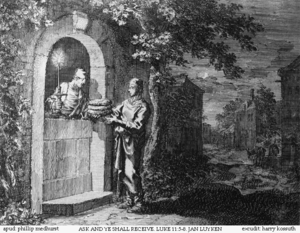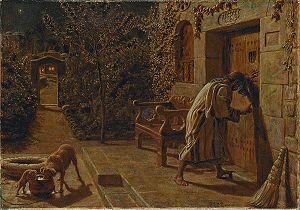Parable of the supplicant friend

The parable of the supplicant, told by Jesus of Nazareth, is about prayer and the answer to prayer. In the Gospels in the New Testament of the Bible it is transmitted only through the Gospel according to Luke ( Lk 11.5–8 EU ) and thus belongs to the Lucanian special property .
content
Jesus tells his disciples to imagine that they went to a friend's house at midnight and asked him for three loaves of bread. The three loaves of bread were intended for another friend who was visiting them in transit and to whom they had nothing to offer. Jesus explains that the friend asked for the loaves will not refuse the request - out of friendship with them, or because of their intrusiveness.
interpretation
In front of the parable ( Lk 11: 1-4 EU ) is a scene in which Jesus teaches his disciples the Our Father . The section based on the parable of the supplicant friend ( Lk 11 : 9–13 EU ) deals with trust in prayer. Through this framework, the theme of the parable becomes clear: It is about prayer and the answer to prayer. Jesus also provides the interpretation of the parable in the following section. The statement contained therein "Ask, and it will be given to you" represents the quintessence of the parable. Asking for the three loaves is therefore to be equated with prayer to God.
There are different interpretations of the way in which the “intrusiveness” described in the last verse should be interpreted. Annette Merz suggests seeing this intrusiveness in the context of the ancient ethics of friendship - for example according to Cicero : The intrusiveness - although not appropriate in everyday life under normal circumstances - is acceptable as behavior among friends, since it takes place in the interests of the guest who has traveled, i.e. in addition contribute that the hospitality towards this traveling friend can be fulfilled; in the same way people should be intrusive towards God in prayer as towards a friend whom they ask for something and who will not refuse this request.

Artistic reception
Various artists have received the parable, the most famous work being The Pushy Neighbor (1895) by William Holman Hunt , which is exhibited in the National Gallery of Victoria in Melbourne .
See also
literature
- Joachim Jeremias : The parables of Jesus (= small Vandenhoeck series. Volume 1500). Short edition. 9th edition. Vandenhoeck & Ruprecht, Göttingen 1984, ISBN 3-525-33498-2 .
- Luise Schottroff : The parables of Jesus. Gütersloher Verlagshaus, Gütersloh 2005, ISBN 3-579-05200-4 .
Web links
Individual evidence
- ↑ Annette Merz: Friendship committed (From the begging friend) ( Memento of the original from November 17, 2015 in the Internet Archive ) Info: The archive link was inserted automatically and has not yet been checked. Please check the original and archive link according to the instructions and then remove this notice. (PDF; 94 kB).